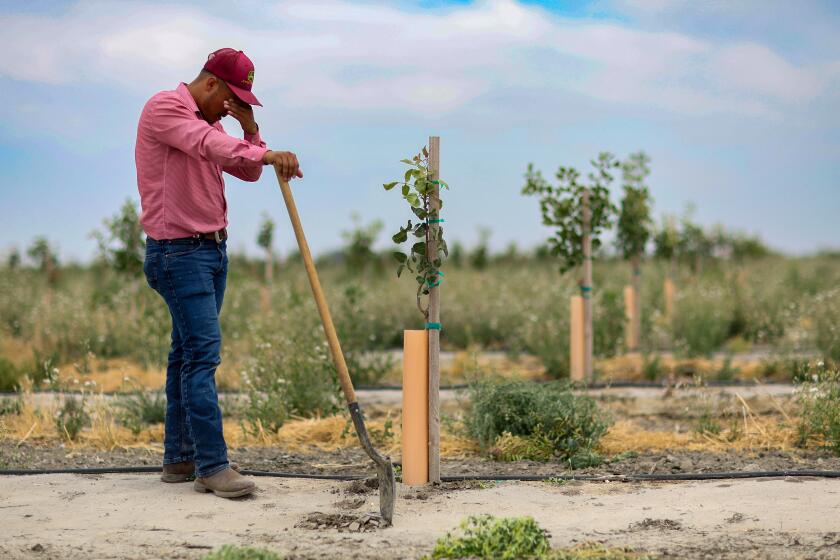Breathing New Life Into Dying Languages : Culture: More than half of the 100 tongues spoken by California’s American Indians are extinct. Only a handful of elders speak the rest, but efforts are being made to preserve them and the history they embody.
The last time Chemehuevi Indian Gertrude Leivas made full use of her native language was more than a decade ago, at her brother’s funeral.
“I surprised myself,” the soft-spoken Leivas said, recalling her improvised eulogy. “The words came out like a string of beads.”
Nowadays, Leivas has no one left to speak Chemehuevi with. At 74 years of age, the bespectacled elder is a member of a species as rare as the California condor.
According to the U.S. Census Bureau, only three people still speak the American Indian language on a regular basis. The situation is similar--or even worse--for most other languages that were born in California.
With 230 non-English tongues spoken at home by 8.6 million of its 29.7 million residents, the Golden State could well be nicknamed the Language State. Yet of nearly 100 languages that originated in California, more than half are extinct and the 30 or so that are still in use are spoken fluently by only a handful of American Indian elders.
Indeed, 1990 federal census statistics show that more California residents speak Kashmiri (89) or Mongolian (87) than such California-bred languages as Yuki, Yokuts, Mohave or Mountain Maidu.
Concerned that the loss of their languages would result in the death of their cultures, California Indian activists have launched a series of last-ditch efforts to help preserve their tongues into the 21st Century.
From Crescent City south to Needles, members of small but resilient Indian tribes are leading instructional classes for youngsters and preparing videotapes and written dictionaries of heretofore oral-only tongues.
And, a privately funded “master-apprentice” immersion program has just begun in which six fluent Indian elders from across the state are providing one-on-one instruction to younger adults for 20 hours or more a week this summer.
Due to the pressures of modern life and the dearth of fluent young speakers, experts remain skeptical whether most native California languages will survive intact into another generation.
“These efforts accomplish a lot for cultural purposes,” said retired UC Santa Cruz linguistics professor William Shipley. “But the languages are very difficult and if you don’t learn them as a native language, or have someone to talk to, you don’t really learn them.
“And there is nobody to talk to.”
Activists, however, say there is no choice but to forge ahead and are hoping to expand their efforts through increased public awareness and programs funded by private and government grants.
“You know how people try to save birds that are headed toward extinction? Well, language--what it means, how it functions--is as important as any animal, fish or any other part of the world,” said Nancy Richardson Riley, a semi-fluent Karuk who works as a language program coordinator at Humboldt State University. “Our languages define our whole world views.
“We’re trying to make our traditional ways fit into a modern and changing world. The only way we’ll stay alive as a people is if we practice and live our culture.”
Before the arrival of European immigrants two centuries ago, California was a veritable language laboratory, with dozens of small bands of natives speaking highly divergent tongues stemming from more than 20 distinct language families.
Besides New Guinea and other southwest Pacific islands--where nearly 25% of the world’s 6,000 languages are spoken--few geographic regions have given birth to as many indigenous languages as California has, experts say.
“California was a place that could support a lot of people aboriginally because of the diversity of its environment,” said longtime UC San Diego linguistics professor Margaret Langdon. “An Indian group could concentrate at a single river (mouth), in contrast to the Great Plains, where a vast area was covered by a single group.
“And in small mountain areas here, a group could be isolated from its neighbors and totally self-supporting.”
As religious and political persecution and epidemics caused the Indian population to dwindle, more than half the state’s nearly 100 indigenous languages disappeared during the last 200 years.
The rest--about 30--have remained alive, barely, due in large measure to defiance of federal efforts during much of the past century to forbid Indians from speaking their own languages while attending government schools.
“Their barbarous dialect should be blotted out and the English language substituted,” stated an 1868 Presidential commission report calling for the establishment of the schools. That policy, according to a 1990 report by the U.S. Senate Select Committee on Indians Affairs, made children “feel like foreigners in their classrooms and homelands.”
Compounding the problem has been the age of instant communications. As linguistics expert James Crawford notes in “Hold Your Tongue,” a new book on bilingualism, “Nowadays it hardly matters that Bureau of Indian Affairs schools have stopped suppressing Indian vernaculars because students often prefer the language of the Teen-Age Mutant Ninja Turtles to that of their ancestors.”
Since the mid-1960s, a resurgence of cultural awareness has resulted in attempts to revive languages and, more recently, a turnabout in governmental attitudes.
“Our society is just beginning to recognize the Native American languages should be viewed as national treasures, part of the heritage of our country,” said Leanne Hinton, director of UC Berkeley’s Survey of California and Other Indian Languages.
In 1990, Congress passed a Native American Languages Act declaring that federal policy should be to “preserve, protect and promote the rights and freedom of Native Americans to use, practice and develop Native American Languages.”
Last fall, additional legislation was approved calling for federal grants to strengthen native languages through classroom instruction and the compilation of oral histories.
“Traditional languages are an important part of this nation’s culture and history and can provide Native Americans with a sense of identity and pride in their heritage,” then-President George Bush said upon signing the bill.
“Of course,” said linguist Langdon, “it’s almost too late, which is the way it always happens.” Moreover, no actual funding accompanied the legislation, nor has any money been included thus far in the fiscal 1994 appropriations bill now before Congress.
Nationwide, the American Indian language with the most speakers is Navajo (148,530), according to 1990 census statistics. In contrast, most languages that originated in California are spoken by fewer than 100 people.
Among them: Foothill North Yokuts, spoken by 78 people; Cahuilla, 32, and Wintu, 9. Other locally bred languages are in even more dire straits: Yuki, with 6 speakers among the 265 tribal members who responded to the federal census; Chemehuevi, 3 out of 570, and Serrano, 2 out of 265.
“I’m almost the only surviving branch of the tree, but I’m still hanging on,” declared Leivas during an interview in her modest desert home a few hundred dusty yards from Lake Havasu. “I’m the last of the Mohicans, just about.”
Like most surviving speakers of indigenous tongues, Leivas, a full-blooded Chemehuevi, grew up in a traditional home where both parents spoke only their native language. She learned English during the late 1920s at an Arizona boarding school, where she was forbidden to speak Chemehuevi.
After marrying a Mexican who spoke English and Spanish only, Leivas raised their children on English.
“It’s easier to express ourselves in English,” said Leivas, after shutting off the soap opera “General Hospital” on the living room TV. “You may have one or two words in Chemehuevi to describe things--but many words to describe the same thing in English.”
At the same time, she expresses a deep sense of pain about the probable demise of her language. Normally cheerful, Leivas verges on downright disdain when describing a handful of elders she knows in Parker, Ariz., whom she says seem “ashamed” to speak Chemehuevi.
To help pass down her traditions, Leivas has worked with her daughter June on compiling a Chemehuevi-English dictionary. The words that don’t exist say as much as those that do about her ancestors’ nomadic desert lifestyle, she says. “We had to develop our own version of some English words we didn’t have words for. We didn’t have words for apples or bananas because we didn’t have apples or bananas. And a spoon is a sipoona .’ ”
Leivas is also teaching her son Matt the words and tunes to the tribe’s traditional funeral dirges, known as “Salt Songs.”
More formal preservation efforts have been largely concentrated in the woodsy northwest corner of the state, where a handful of public schools offer courses in Yurok, Hupa, Karuk and Tolowa.
In Crescent City, high school students can study Tolowa as a fine arts elective--just as they would Spanish, Latin or dance band. Although the class was dropped last year because of budget cuts, it is due to resume this fall with an enrollment of 22 students, according to 12-year teacher Loren Bommelyn.
In nearby Yreka, the Karuk tribe runs a weekly transportation service bringing together its fluent elders. “They’re so spread out that they would otherwise never talk to each other--except when going to funerals,” said Humboldt State University’s Riley.
Elsewhere, language advocates are employing computer-age tools to make lasting records of endangered tongues.
Mary Jones, 74, who lives in the hills outside Oroville, recently taped a sample one-hour lesson in Konkow phonetics with Brian Bibby, a former college instructor who is also independently developing an interactive computer language learning program in the Northern Miwuk language.
“There’s nobody here I can speak with anymore,” Jones said. “I had two brothers who I lived with. We spoke to each other and could kid in the language, but now they’re gone.”
Several other Californians are attempting to relearn extinct languages from Smithsonian Institution field notes compiled in the early 1900s. By studying the Rumsen language of her Monterey Bay-area ancestors, Seaside resident Linda Yamane has found an opportunity to breathe new life into words that had not been uttered for seven decades.
“It connects me to the people that I came from,” Yamane explained. “But there’s even an extra special thing because of having felt like it was gone, like it was lost.
“I pick things to learn I can relate to. Certain animals are important to me and important to the culture, like coyote--the first compound word I learned. It’s spelled tja tja kiy matchan . Matchan itself is a dog and tja tja kiy means wild.
“The reward is so great. Even small things feel like immense things.”
The newly created master-apprentice program, launched by a statewide activist group called Advocates for Indigenous California Language Survival (AICLS), consists of two-person teams specializing in the Mohave, Yurok, Karuk, Wintu, Hupa and Yowlumni languages.
For four months, Claude Lewis, 73, a retired electric lineman, is teaching Mohave (AhaMakav) words and phrases to Parris Butler, 37, an artist who now serves as chairman of the AICLS.
“One of our projects is making artifacts--bows and arrows,” said Lewis, a Needles resident. “We look for the feathers of dead birds and I point out how to say each of these things in our language.”
On the hilly Tule River Reservation outside Porterville, shiatsu massage therapist Matt Vera, 34, spends several hours a day learning Yowlumni from a closely related “master”--his mother, Agnes, 67.
While growing up in town, Matt was taught a handful of Indian words, but never thought twice about English being his primary language. “I guess we took it for granted,” he said. “It was an era of not being into cultural preservation of any kind.”
After returning to the Tule reservation in the late 1970s, Matt began studying his cultural and religious background, which in turn kindled a passionate interest in his native language.
One recent afternoon, Matt and his mother journeyed into the woods east of Visalia to prepare a traditional sweat lodge for an evening religious ceremony.
While gathering dead branches and logs from pine, walnut and oak trees to build a fire that would heat the rocks, he repeatedly asked his mother, “How wethook ma we on. . . ?” It translates in English to “How do you say. . . ?”
Later that day, Matt took his new vocabulary words to the North Visalia Community Center, where he was in the third week of teaching a basic Yowlumni language class. Seated in a circle were fellow tribe members, age 3 to 67, whom he taught phrases ranging from “yama shoqhonos” (let’s go to town) to “qhono na alsal” (I always pray).
At dusk, the Veras, accompanied by eight friends and relatives, returned to the low-slung canvas lodge, set in a grove amid giant blackberry bushes and wild grapes. There, in the steamy, superheated darkness, they chanted rhythmically, giving thanks to the Creator for their lives and for the soul of a recently departed elder. The soaring, melodic chanting, needless to say, was done in their native tongue.
“Our prayers are all very sacred and we say them through our Indian language,” said Agnes Vera, a former child-care worker and guide at Sequoia National Park. “We live it every day, throughout the day. We don’t just go to church on Sunday.
“If we tried to pray in English, the way we did in our language, it would just have no meaning,” she continued. “There would be no more Indians. It would be the end of our culture.”
Disappearing Native Languages
Although more than 8.6-million of California’s 29.7-million residents speak a language other than English at home, only a relative handful speak any of the Native American languages that actually originated here.
This chart shows the number of Californians who speak the following American Indian languages at home. Letters indicate where most speakers of the language live. Language: Speakers A. Mono: 184 B. Yurok:152 C. Hupa: 93 D. Foothill North Yokuts: 78 E. Mountain Maidu: 74 F. Karuk: 59 G. Mohave: 53 H. Cahuilla: 32 I. Chemehuevi: 3 J. Serrano: 2 *
A California Sampler
By comparison, the number of speakers of some other languages in California Language: Speakers English: 21.1 million Spanish: 5.5 million Tagalog (Philippines): 464,644 Greek: 32,889 Tamil (India, Sri Lanka): 3,844 Pashto (Afghanistan, Pakistan): 2,935 Cushite (Ethiopia, East Africa): 452 Mongolian: 87 Berber (North Africa): 20 Source: 1990 U.S. Census Bureau statistics
More to Read
Sign up for Essential California
The most important California stories and recommendations in your inbox every morning.
You may occasionally receive promotional content from the Los Angeles Times.






